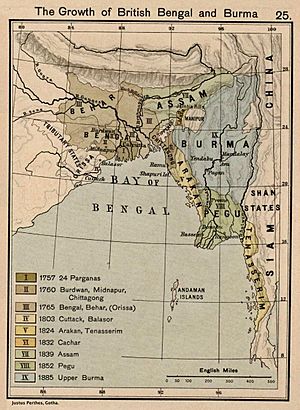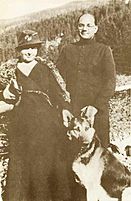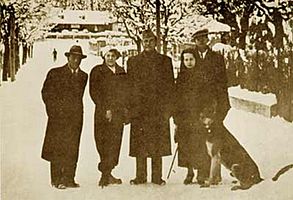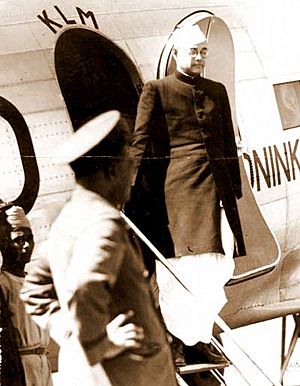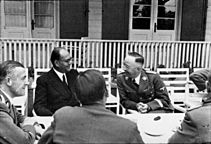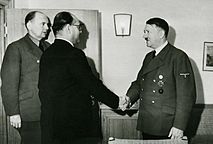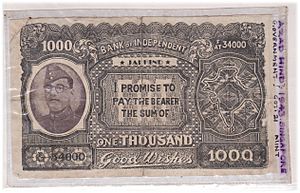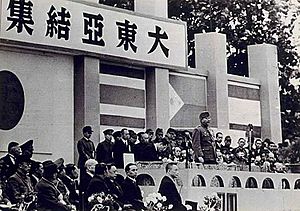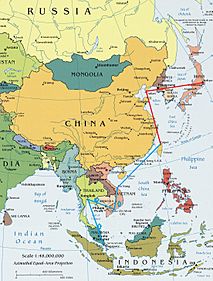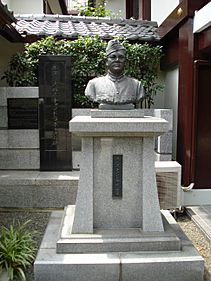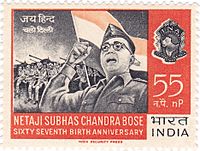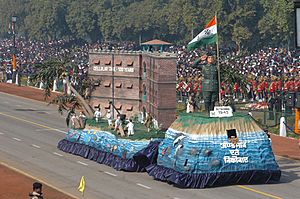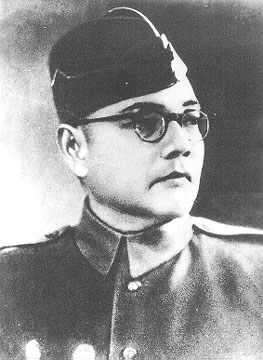Subhas Chandra Bose facts for kids
Quick facts for kids
Netaji
Subhas Chandra Bose
|
|
|---|---|
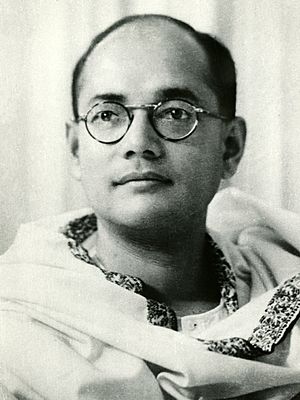
Bose c. 1930s
|
|
| 2nd Leader of Indian National Army | |
| In office 4 July 1943 – 18 August 1945 |
|
| Preceded by | Mohan Singh |
| Succeeded by | Office abolished |
| President of the Indian National Congress | |
| In office 18 January 1938 – 29 April 1939 |
|
| Preceded by | Jawaharlal Nehru |
| Succeeded by | Rajendra Prasad |
| President and Founder of All India Forward Bloc | |
| In office 22 June 1939 – 16 January 1941 |
|
| Preceded by | Office created |
| Succeeded by | Sardul Singh Kavishar |
| 5th Mayor of Calcutta | |
| In office 22 August 1930 – 15 April 1931 |
|
| Preceded by | Jatindra Mohan Sengupta |
| Succeeded by | Bidhan Chandra Roy |
| Personal details | |
| Born |
Subhas Chandra Bose
23 January 1897 Cuttack, Orissa Division, Bengal Province, British India (now in Cuttack district, Odisha, India) |
| Died | 18 August 1945 (aged 48) Army Hospital Nanmon Branch, Taihoku, Japanese Taiwan (present-day Taipei City Hospital Heping Fuyou Branch, Taipei, Taiwan) |
| Cause of death | Third-degree burns from aircrash |
| Political party | Indian National Congress All India Forward Bloc |
| Spouses |
Emilie Schenkl
(m. 1937)(secretly married without ceremony or witnesses, unacknowledged publicly by Bose.) |
| Children | Anita Bose Pfaff |
| Parents |
|
| Education |
|
| Alma mater |
|
| Known for | Indian independence movement |
| Signature | |
Subhas Chandra Bose (born January 23, 1897 – died August 18, 1945) was an Indian nationalist leader. He bravely stood up against British rule in India. Many Indians saw him as a hero. However, his choices to work with Nazi Germany and Imperial Japan during World War II created a complicated legacy. He was given the special title Netaji (which means "Respected Leader" in Hindi) in Germany in 1942. This title is now used all over India.
Subhas Bose was born into a wealthy family in Orissa, during the time India was ruled by the British. He received an English-style education. After college, he went to England to take a difficult exam for the Indian Civil Service. He passed the first part with high marks but decided not to take the final exam. He felt that fighting for his country's freedom was more important.
In 1921, Bose returned to India and joined the movement for independence. This movement was led by Mahatma Gandhi and the Indian National Congress. Bose became a leader within the Congress party who wanted faster change and was interested in socialism. He became the president of the Congress in 1938. After being re-elected in 1939, he had disagreements with other leaders, including Gandhi. These differences were about how India should be governed and Bose's willingness to use methods other than non-violence. Because of these disagreements, Bose resigned as president and later left the party.
In April 1941, Bose went to Nazi Germany. The German leaders showed some interest in India's independence. With German money, a Free India Centre was opened in Berlin. A group of 3,000 Indian prisoners of war, captured by German forces, formed the Free India Legion to fight under Bose. However, the Germans did not fully support Bose because they thought he was not as popular as Gandhi or Jawaharlal Nehru. By 1942, the German army was struggling in the Soviet Union. Bose was disappointed and wanted to move to Southeast Asia, where Japan had won many battles. In May 1942, Adolf Hitler met Bose and helped him travel by submarine to East Asia. During this time, Bose and Emilie Schenkl had a daughter, Anita Bose Pfaff.
Bose strongly supported the Axis powers. In February 1943, he traveled by German and then Japanese submarine to Sumatra, which was controlled by Japan. With Japan's help, Bose reorganized the Indian National Army (INA). This army was made up of Indian soldiers who had been captured by the Japanese in the Battle of Singapore. A Provisional Government of Free India was set up in the Japanese-controlled Andaman and Nicobar Islands, with Bose as its leader.
Even though Bose was a strong and inspiring leader, the Japanese thought he was not skilled in military matters. The INA's efforts in battle were short-lived. In late 1944 and early 1945, the Indian Army, fighting for the British, pushed back against the Japanese attack on India. Many Japanese and INA soldiers were killed. The remaining INA forces retreated and surrendered when Singapore was taken back by British forces. Bose tried to escape to Manchuria, hoping to find support in the Soviet Union. He died on August 18, 1945, from severe burns when his plane crashed in Japanese Taiwan.
Some Indians did not believe Bose had died, hoping he would return to help India gain independence. The Indian National Congress praised Bose's love for his country but disagreed with his methods. The British, who were not seriously threatened by the INA, charged 300 INA officers with treason. However, they later dropped these charges due to public opposition and Britain's new plan to quickly grant India independence.
Bose's legacy is complex. Many in India see him as a strong hero who fought for freedom. However, his alliances with Japanese Fascism and Nazism raise difficult questions.
Contents
Early Life and Education
Growing Up in Cuttack
Subhas Chandra Bose was born on January 23, 1897, in Cuttack. This area is now part of Odisha, India, but back then it was part of British India. His parents were Prabhavati Bose and Janakinath Bose. Prabhavati was the heart of the family and had 14 children; Subhas was the ninth. Janakinath was a successful lawyer who was loyal to the British government. He was a self-made man who always remembered his roots in a small village.
In 1902, Subhas started at the Baptist Mission's Protestant European School in Cuttack. English was the main language taught there. The school focused on English, Latin, the Bible, and British history. No Indian languages were taught. His father wanted his sons to speak perfect English, believing it was important for dealing with the British.
At home, however, only Bengali was spoken. His mother taught him about Hindu goddesses and told stories from the epics like Mahabharata and Ramayana. From her, Subhas learned to be caring and to help others. He preferred gardening to playing sports. His father was often busy, making Subhas feel his childhood was ordinary. Still, his father loved English literature, and several of his sons, including Subhas, also became interested in it.
In 1909, at age 12, Subhas followed his brothers to the Ravenshaw Collegiate School in Cuttack. Here, he also learned Bengali and Sanskrit. He began to wear Indian clothes and think deeply about religion. He wrote letters to his mother about the ideas of famous Indian mystics like Ramakrishna Paramahamsa and Swami Vivekananda. Despite his religious interests, Subhas was a good student. In 1912, he placed second in the high school exam for the University of Calcutta.
College Years and Expulsion
In 1913, Subhas joined his brothers at Presidency College in Calcutta. He studied philosophy, reading works by Western thinkers. He became close friends with Hemanta Kumar Sarkar, sharing religious thoughts. In 1914, they traveled to northern India looking for a spiritual teacher, or guru. His family worried when he was gone, and his parents were upset when he returned. His older brother, Sarat Chandra Bose, helped calm things down. Subhas then focused on his studies, debates, and student journalism.
In February 1916, Bose was involved in an incident with Professor E. F. Oaten. Students claimed Oaten had insulted Indian culture and pushed some students. Oaten said students were being too loud outside his class. A few days later, some students attacked Oaten on a stairway. Bose was accused of being involved and was expelled from the college and the University of Calcutta. This shocked his family. His family used their connections to help him, and in July 1917, he was allowed to return to a different college. He joined Scottish Church College and earned his B.A. in philosophy in 1918, placing second in the university.
Indian Civil Service Exam
His father wanted Subhas to take the Indian Civil Services (ICS) exam in England. Bose arrived in London in October 1919 and applied for the ICS. He also wanted to get into University of Cambridge. He was accepted into a program that allowed him to study at the university without being formally admitted to a college. He began preparing for the Civil Service exams.
In August 1920, Bose took the ICS exam and placed fourth, which was a great achievement. He still had a final exam in 1921 on Indian law, history, and language, plus a riding test. Bose felt he could easily pass these. However, he started to have doubts about taking the final exam. He wrote many letters to his father and brother, Sarat Chandra Bose, in Calcutta. In April 1921, he decided not to take the final exam, telling his brother he was sorry for the pain it would cause his family. He wrote to the British Secretary of State for India, asking to be removed from the list of ICS candidates.
Bose had been in touch with C. R. Das, a leading politician in Bengal, who encouraged him to return to Calcutta. With his ICS decision made, Bose took his Cambridge B.A. exams without much effort, passing with a lower grade. He sailed for India in June 1921.
Joining the Independence Movement
Working with Congress
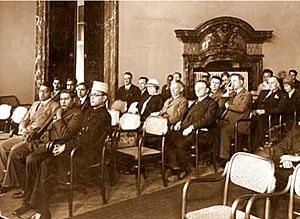
Subhas Bose arrived in India in July 1921 and immediately met with Mahatma Gandhi. Bose later wrote that he questioned Gandhi a lot, finding his answers unclear. Gandhi believed in non-violence, while Bose thought all methods were acceptable to achieve freedom. They also disagreed on how India should be governed. Gandhi sent Bose to Chittaranjan Das, a leader in Bengal. Bose found Das to be the leader he was looking for, as Das was more open to stronger actions for independence. Bose worked with the Indian National Congress for nearly 20 years, trying to guide its path.
He started a newspaper called Swaraj and managed publicity for the Bengal Congress. In 1923, Bose became president of the Indian Youth Congress and secretary of the Bengal State Congress. He also edited the newspaper "Forward," started by Chittaranjan Das. When Das became mayor of Calcutta in 1924, Bose worked as the CEO of the Calcutta Municipal Corporation. That same year, he was arrested during a protest and sent to prison in Mandalay, where he got tuberculosis.
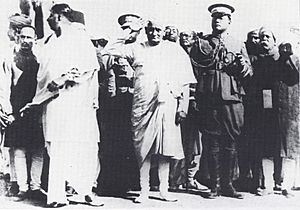
After being released from prison in 1927, Bose became general secretary of the Congress party. He worked with Jawaharlal Nehru for India's independence. In December 1928, Bose helped organize the annual meeting of the Indian National Congress in Calcutta. He played a key role as the leader of the Congress Volunteer Corps. Later, Bose was arrested again for civil disobedience. After his release, he became Mayor of Calcutta in 1930.
Travels in Europe
In the mid-1930s, Bose traveled around Europe. He met Indian students and European politicians, including Benito Mussolini. He studied how political parties were organized and saw how communism and fascism worked. During this time, he also wrote the first part of his book, The Indian Struggle, about India's independence movement from 1920 to 1934. The British government banned the book in India, fearing it would cause unrest. In Europe, the Indian Central European Society in Vienna supported Bose.
In 1937, Subhas Bose married Emilie Schenkl. They later had a daughter, Anita Bose Pfaff.
Congress Presidency and Disagreements
In 1938, Bose believed the Congress should fight for both political freedom and a socialist government. He became president of the Congress. He wanted complete self-governance and was willing to use force against the British. This led to disagreements with Mahatma Gandhi, who opposed Bose's presidency.
Bose tried to keep the party united. He was re-elected president in 1939, even though Gandhi supported another candidate. However, due to actions by Gandhi's supporters in the Congress Working Committee, Bose was forced to resign from the presidency.
On June 22, 1939, Bose formed the All India Forward Bloc. This was a group within the Congress aimed at uniting left-wing politicians, but it was strongest in his home state of Bengal.
Bose believed that an independent India would need a strong, socialist government for at least two decades, similar to Turkey under Kemal Atatürk. He tried to meet Atatürk but was denied permission by the British. In England, Bose met with leaders from the British Labour and Liberal parties to discuss India's future. Conservative Party officials refused to meet him because he was from a colony. India eventually gained independence under a Labour Party government.
When World War II began, Bose wanted a large protest against the British Viceroy's decision to declare war on India's behalf without asking Indian leaders. When Gandhi disagreed, Bose organized protests in Calcutta, calling for the removal of the "Holwell Monument." He was jailed but released after a seven-day hunger strike. His house was then watched by British police.
World War II and the Indian National Army
Escape to Germany
Bose's arrest and release set the stage for his escape to Nazi Germany. He planned to travel through Afghanistan and the Soviet Union. To avoid being recognized, he grew a beard and dressed as a Pathan. On the night of January 17, 1941, he escaped from his home in Calcutta with his nephew, Sisir Kumar Bose. They reached Gomoh Railway Station.
He traveled to Peshawar with help from German intelligence. There, he met local supporters. On January 26, 1941, Bose began his journey to Russia through Afghanistan. He pretended to be a deaf and mute Pashtun insurance agent named "Ziaudddin" and let his beard grow to blend in with local tribesmen. His guide, Bhagat Ram Talwar, was secretly a Soviet agent.
Supporters helped him cross into Afghanistan. He then met a German unit pretending to be road construction engineers, who helped him travel through Afghanistan to the Soviet Union. In Moscow, he hoped for Russian support against the British, but he was disappointed. He was quickly sent to the German Ambassador in Moscow, who arranged for him to fly to Berlin in early April. In Berlin, he received a more positive response from German officials.
Working with Nazi Germany
In Germany, Bose worked with the Special Bureau for India. He broadcast messages on the German-sponsored Azad Hind Radio. He also started the Free India Center in Berlin. He created the Indian Legion, which had about 4,500 soldiers. These soldiers were Indian prisoners of war who had fought for the British in North Africa and were captured by Axis forces. The Indian Legion was part of the German army. Its members swore an oath to both Hitler and Bose. Bose was also willing to consider a German invasion of India through the USSR, led by the Indian Legion. Many people questioned this idea, as it seemed unlikely the Germans would leave India after such an invasion.
Bose lived in a luxurious home provided by the German Foreign Office. Emilie Schenkl lived with him, and in November 1942, their daughter was born.
The Germans were not keen on a full alliance with Bose, believing he was less popular than Gandhi or Nehru. By spring 1942, the German army was stuck in the USSR. Bose was disappointed by Germany's lack of strong support. He wanted to move to Southeast Asia, where Japan had won quick victories. In May 1942, Adolf Hitler met Bose but refused his requests for more help. Instead, Hitler arranged for Bose to travel by submarine to East Asia.
In February 1943, Bose left Emilie and their baby daughter. He boarded a German submarine to travel to Japanese-occupied Southeast Asia. Bose had hoped Germany would help drive the British from India, but he realized this was unlikely. When he met Hitler in May 1942, he felt that Hitler was more interested in using his men for propaganda than for military victories. So, Bose left for Japan, leaving his recruited soldiers in Germany feeling leaderless.
Leading the Indian National Army

In 1943, Bose realized Germany could not help India gain independence. He traveled to Japan by German and then Japanese submarine. This was the only time during World War II that a civilian was transferred between two submarines of different navies.
The Indian National Army (INA) was first thought of by Japanese Major Iwaichi Fujiwara. He wanted to create an army that would fight alongside the Japanese. The first INA was formed in December 1941 by Mohan Singh, an Indian Army captain captured by the Japanese. However, this first INA was disbanded in December 1942 due to disagreements with the Japanese, as Mohan Singh felt the Japanese were just using the INA.
The idea of an independence army was revived when Subhas Chandra Bose arrived in the Far East in 1943. In July, in Singapore, Rash Behari Bose handed over control of the organization to Subhas Chandra Bose. Bose was able to reorganize the army and gain huge support from Indians living in Southeast Asia. They joined the INA and gave money to support the fight for independence. The INA even had a women's unit, the Rani of Jhansi Regiment, named after Rani Lakshmi Bai. This was one of the first women's units of its kind in Asia.
Even when facing military defeats, Bose kept support for the Azad Hind movement strong. In a speech in Burma on July 4, 1944, Bose gave his most famous quote: "Give me blood, and I shall give you freedom!" He urged Indians to join his fight against British rule. The INA was part of a provisional government, the Azad Hind Government. This government issued its own currency and stamps and was recognized by nine Axis countries.
The INA first fought in the Japanese push towards the eastern Indian borders of Manipur. INA special forces were involved in operations behind enemy lines.
The Japanese also took control of the Andaman and Nicobar Islands in 1942. A year later, the Provisional Government and the INA were set up there. However, the Japanese Navy kept control of the islands. During Bose's only visit to the islands in early 1944, he was kept away from the local people by his Japanese hosts.
On the Indian mainland, an Indian flag, similar to the one used by the Indian National Congress, was raised for the first time in Moirang, Manipur. The nearby towns of Kohima and Imphal were surrounded by Japanese and Burmese armies, working with INA brigades. This attempt to conquer mainland India was called Operation U-Go.
During this operation, on July 6, 1944, Bose spoke on Azad Hind Radio from Singapore. He called Mahatma Gandhi the "Father of the Nation" and asked for his blessings for the war. This was the first time Gandhi was called by this title. The Japanese attempts to take Kohima and Imphal failed, using up many Japanese resources. Commonwealth forces fought back, causing heavy losses to the Axis forces, who were forced to retreat into Burma. After these defeats, Bose's dream of setting up a base in mainland India was lost.
The INA continued to fight in key battles against the British Indian Army in Burma. However, with the fall of Rangoon, Bose's government lost its power. Many INA troops surrendered. The remaining troops retreated with Bose towards Malaya or Thailand. Japan's surrender at the end of the war also led to the surrender of the remaining INA forces. The INA prisoners were sent back to India, and some were tried for treason.
Death
Subhas Chandra Bose died on August 18, 1945. His overloaded Japanese plane crashed in Japanese-ruled Formosa (now Taiwan).
Bose's body was cremated two days later. On August 23, 1945, the Japanese news agency announced his death. On September 7, a Japanese officer carried Bose's ashes to Tokyo. A memorial service was held on September 14, and his ashes were given to the priest of the Renkōji Temple in Tokyo, where they have remained since.
Many INA members were shocked and saddened by his death. In India, the Indian National Congress leader Mahatma Gandhi said, "Subhas Bose has died well. He was undoubtedly a patriot, though misguided." Many Congress members had not forgiven Bose for disagreeing with Gandhi and for working with what they saw as Japanese fascism. The Indian soldiers who fought for the British were divided about the INA. Some saw them as traitors, while others felt sympathy. The British tried 300 INA officers for treason, but later dropped the charges due to public pressure and a new British policy to grant India independence quickly.
Ideology and Beliefs
Influences and Vision
Subhas Chandra Bose believed the Bhagavad Gita was a great source of inspiration for fighting the British. The teachings of Swami Vivekananda on universalism, nationalism, and social service deeply inspired him from a young age. He found new meaning in India's ancient scriptures. Some scholars believe that Hindu spirituality was a key part of his political and social ideas. He was different from many other socialists and communists in India because he continued to explore his religious beliefs.
In 1930, Bose said he preferred "a mix of what modern Europe calls socialism and fascism." He later disagreed with Nehru's idea that there was "no middle road" between communism and fascism. Bose thought communism would not succeed in India because it rejected nationalism and religion. He suggested that a "mix between communism and fascism" could work instead. In 1944, Bose also stated that "Our philosophy should be a synthesis between National Socialism and communism."
Views on Governance
Bose believed that a strong, authoritarian government could help India gain freedom and rebuild its society. He admired the methods he saw in Italy and Germany in the 1930s, thinking they could be used to build an independent India.
Many Congress leaders felt Bose's plans were too similar to those of Japanese fascists. After losing influence within the Congress, Bose chose to work with fascist governments as allies against the British and left India. Bose believed India "must have a political system—State—of an authoritarian character," and "a strong central government with dictatorial powers for some years to come."
Earlier, Bose had said that democracy was the best choice for India. However, during the war, he seemed to decide that no democratic system could solve India's poverty and social problems. He wrote that a socialist state, like Soviet Russia (which he also admired), would be needed for national rebuilding. Some people suggest that Bose's alliance with the Axis powers during the war was not just practical but also reflected his strong nationalist beliefs. Others argue that he might have been using popular methods common to many leaders in countries gaining independence.
Famous Quotes
His most famous quote was "Give me blood and I will give you freedom!" Another well-known quote was Dilli Chalo ("On to Delhi)!" This was a call he used to motivate the INA armies. Another slogan he created was "Ittehad, Etemad, Qurbani" (Urdu for "Unity, Agreement, Sacrifice").
Legacy and Memorials
Bose's challenge to British rule made him a hero to many Indians. However, his alliances with Nazi Germany and Imperial Japan during the war left a legacy that included authoritarianism, controversial views, and military failures.
Bose has been featured on stamps in India many times since 1964. He has also appeared on Indian coins. The Netaji Subhas Chandra Bose International Airport in Kolkata, Netaji Subhash Chandra Bose Island (formerly Ross Island), and many other places in India are named after him. In 2007, the Japanese Prime Minister, Shinzō Abe, visited the Netaji Bhawan in Kolkata. Abe said that the Japanese people were deeply moved by Bose's strong will to lead the Indian independence movement.
In 2021, the Government of India declared January 23 as Parakram Divas (Day of Valour) to celebrate Subhas Chandra Bose's birthday. A holographic statue of Bose was placed at the India Gate to mark his 125th birth anniversary, and a permanent granite statue later replaced it.
In Popular Media
- Netaji Subhash (1947) was a documentary film about Bose.
- Subhas Chandra (1966) and Neta Ji Subhash Chandra Bose (1966) are Indian biographical films about him.
- In 2004, Shyam Benegal directed Netaji Subhas Chandra Bose: The Forgotten Hero. This film showed his life in Nazi Germany and Japanese-occupied Asia, and how the Azad Hind Fauj was formed.
- His Majesty's Opponent (2011) is a biography of Bose written by Sugata Bose.
- Bose: Dead/Alive (2017) is a web series that explores theories about Bose's death.
- Netaji (2019) is a daily television series.
- Gumnaami (2019) is a Bengali mystery film about the mystery surrounding Netaji's death.
Images for kids
-
Bose at the opening of the India Society in Prague in 1926.
-
Subhas Bose (in military uniform) with Congress president, Motilal Nehru at the Indian National Congress meeting, December 1928.
-
Bose, INC president-elect, center, in Bad Gastein, Austria, December 1937, with (left to right) A. C. N. Nambiar, Heidi Fulop-Miller, Schenkl, and Amiya Bose.
-
Bose with Heinrich Himmler, head of the SS.
-
Bose meeting Adolf Hitler.
-
The crew of Japanese submarine I-29 after meeting German submarine U-180 near Madagascar. Bose is sitting in the front row (April 28, 1943).
See also
 In Spanish: Subhas Chandra Bose para niños
In Spanish: Subhas Chandra Bose para niños
- Revolutionary movement for Indian independence
- Japanese occupation of Singapore
- Bombing of Rangoon in World War II
- Death of Subhas Chandra Bose
- Political views of Subhas Chandra Bose
- Bengal Volunteers
- Bibliography of Subhas Chandra Bose
- Subhasji
- Qadam Qadam Badhaye Ja
- Gumnami Baba


